Once you try this focaccia bread recipe, you’ll never go back to plain bread! This hearty No-Knead Focaccia bread has tons of airy bubbles and is coated in olive oil and herbs, making every bite full of delicious flavor. And the best part? This easy no knead technique only takes about 5 minutes of hands-on work to make an amazing loaf. This delicious focaccia bread pretty much makes itself!
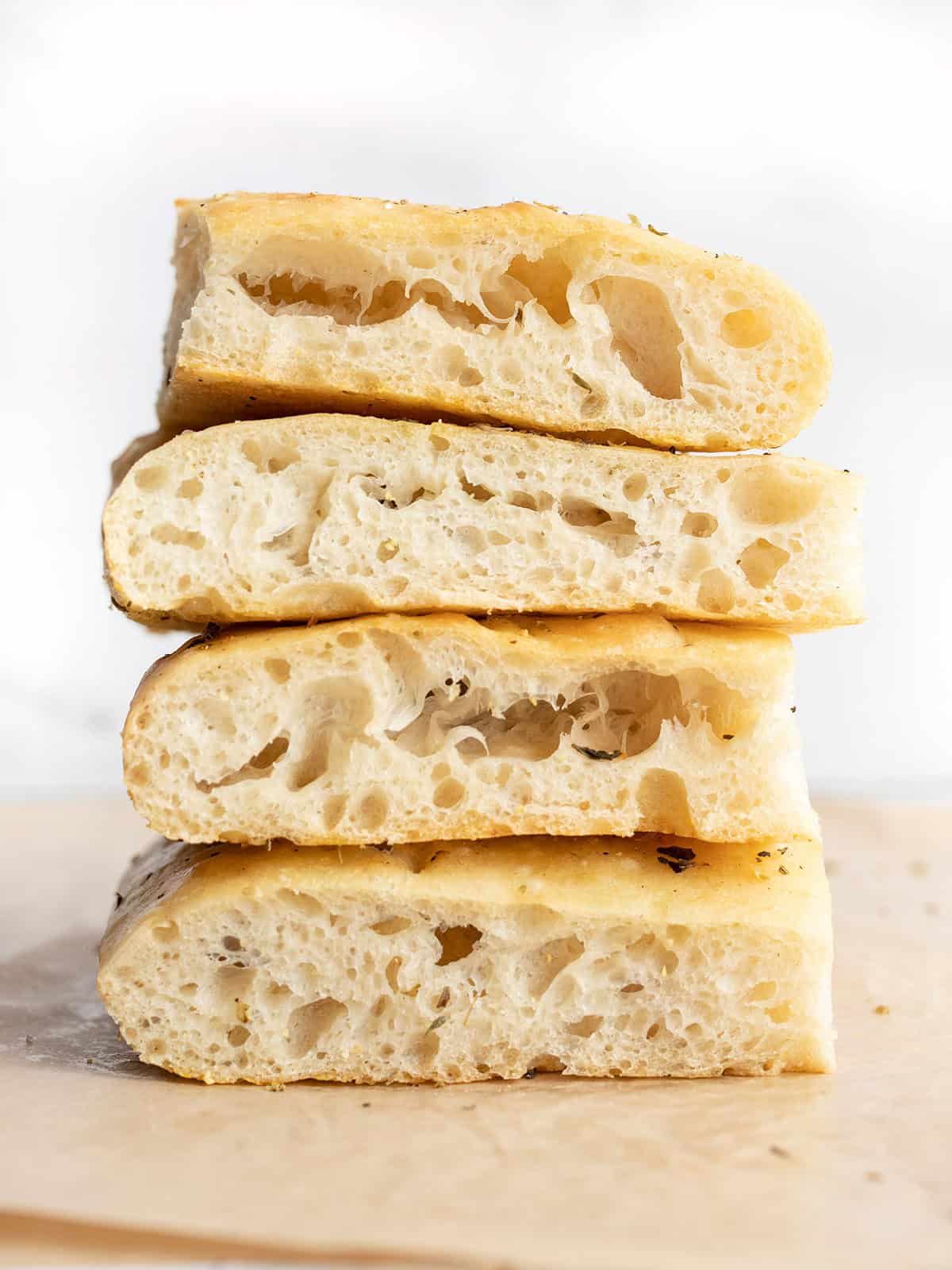
This post contains some affiliate links, which means that we make a small commission off items you purchase at no additional cost to you.
What is Focaccia?
Focaccia bread is an Italian flatbread known for its thick, fluffy texture with plenty of large bubbles. It is often rectangular or circular in shape and is made with high-gluten flour and plenty of olive oil, which gives it a unique texture and flavor. Focaccia can be seasoned with herbs, cheese, or even vegetables and is often used for sandwiches, dipping into soups or sauces, or even as thick base for pizza.
Ingredients for No Knead Focaccia Bread
This super simple no knead focaccia bread recipe only uses a few simple ingredients:
- Flour: Traditionally, focaccia is made with a high-gluten flour that gives it extra strength and a deliciously chewy texture. We crafted this recipe using all-purpose flour to reduce the need to purchase special ingredients. You can use high-gluten flour if you prefer, but the water-to-flour ratio may change slightly.
- Instant Yeast: Because this focaccia recipe uses a no-knead technique, we must use instant yeast which does not need to be bloomed in warm water to activate.
- Salt: Salt helps give the focaccia bread flavor. Without salt, bread can be quite bland and flavorless.
- Water: Water hydrates the flour and helps the yeast activate.
- Olive Oil: Olive oil keeps the focaccia dough from sticking, gives the bread’s crust a wonderful texture, and provides a classic flavor.
- Cornmeal: We use cornmeal to give the bottom crust of the focaccia bread a nice crispy texture, but it is optional.
- Italian Seasoning: A simple Italian seasoning blend is used to give the bread even more flavor, but you can experiment with your focaccia bread with other herbs, spices, cheese, or even vegetables.
Can I Use Whole Wheat Flour?
Yes, you can substitute some of the all-purpose flour for whole wheat flour. Using all whole-wheat flour generally creates a very heavy and dense bread, so I highly suggest using only some, up to 50%, whole wheat flour. You may need to use slightly more water, as whole wheat flour absorbs more moisture than all-purpose flour.
The No Knead Bread Technique
Regular bread baking requires the dough to be kneaded a long time to make the gluten strands line up and form a sort of matrix that gives the dough strength and texture. With no-knead bread, the dough is allowed to ferment overnight. During fermentation enzymes break down the gluten in a process called autolysis, which makes it easier for them to untangle, line up, and form the matrix that usually takes a lot of kneading to form.
An added bonus is that overnight fermentation adds a lot of flavor to the bread. AND, since the yeast has so much time to grow and multiply, you only need to use ¼ tsp yeast, compared to about 2 tsp for a normal loaf of bread! Win-win!
What Do You Serve With No Knead Focaccia?
Focaccia is such a versatile bread! It makes a great side dish with just about any meal, but I think it’s particularly nice with soups and stews. Its hearty texture makes it great for dipping, dunking, and sopping up sauces, stews, and soups. Focaccia bread is also fantastic for sandwiches, especially pressed sandwiches like paninis. You can also use this bread to make pizzas or flatbreads. Simply top it with your favorite cheese, meat, or vegetables and bake again until the cheese is melted and bubbly. Or, if you’re just a bread fanatic like me, slice it into sticks, dip it in some homemade marinara sauce, and call it a day!
How to Store Focaccia Bread
After baking, make sure to allow the focaccia bread to cool completely to room temperature before storing to prevent condensation. Once cooled, you can keep the bread at room temperature in an air-tight container for about two days. If you can’t consume the entire loaf within two days, consider freezing a portion of it for longer storage.
To freeze the focaccia bread, simply let it cool completely until it is room temperature, cut it into slices (whichever size or shape you prefer), then place it in a gallon-sized freezer bag. The frozen no-knead focaccia thaws quickly at room temperature.
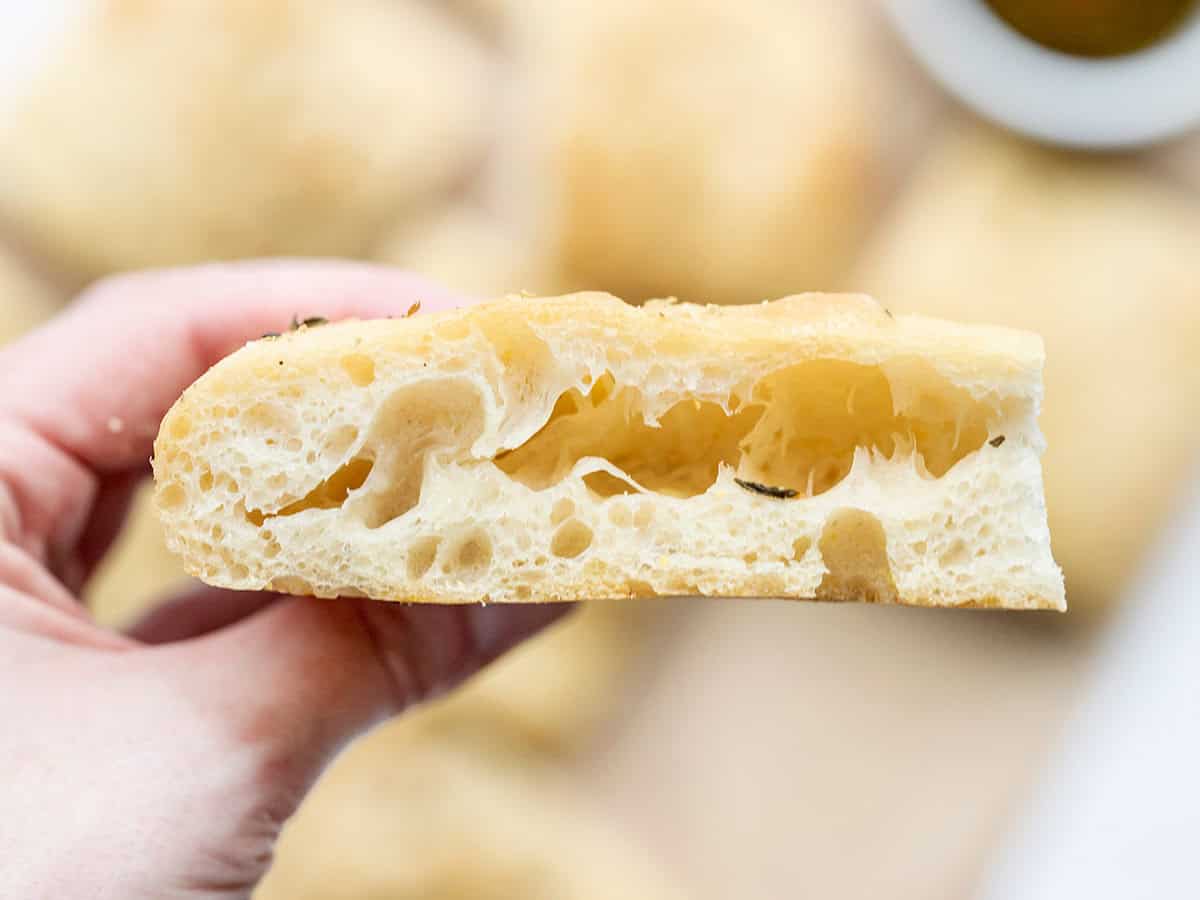
No Knead Focaccia Bread

Ingredients
- 4 cups all-purpose flour ($0.61)
- 1/4 tsp instant yeast ($0.02)
- 1 1/2 tsp salt ($0.03)
- 2 cups water ($0.00)
- 2 Tbsp olive oil, divided ($0.32)
- 2 Tbsp cornmeal ($0.03)
- 1 Tbsp Italian seasoning ($0.30)
Instructions
- The night before, combine the flour, salt and yeast in a bowl. Stir until everything is evenly combined. Add the water and stir until it forms one cohesive, sticky, shaggy ball of dough with no dry flour left on the bottom of the bowl. If there is still dry flour in bowl, add a little water (1-2 Tbsp) until the dough comes together (scroll down to the step by step photos for examples). Loosely cover the bowl and let sit at room temperature for 12-18 hours.
- The next day the dough will be wet, bubbly, and very fluffy. Dust the top of the dough with some flour, then scrape the dough from the sides of the bowl. Turn the dough over on itself a few times until it forms a ball in the center of the bowl.
- Line a baking sheet with foil then drizzle with 1 Tbsp olive oil. Spread the oil to coat the surface of the foil, then sprinkle cornmeal on top of the oil.
- Transfer the dough to the baking sheet. Stretch and pat the dough out into a large rectangle. You may need to dust your hands with flour throughout this process to keep the dough from sticking.
- Drizzle olive oil over the surface of the dough and use a soft brush to spread it evenly over the surface. Sprinkle the Italian seasoning (or any type of herbs) over top. Let the dough rise for another hour.
- Preheat the oven to 425ºF. Using your fingers, press dimples into the risen dough. Bake the focaccia for 20-25 minutes in the preheated oven or until the surface is golden brown. After removing from the oven, allow the focaccia to cool before slicing and serving.
See how we calculate recipe costs here.
Equipment
- Measuring Cups Spoons
- Liquid Measuring Cup
- Enamelware Sheet Pan
Nutrition

How to Make No Knead Focaccia Bread – Step By Step Photos

Start with 4 cups all-purpose flour, ¼ tsp instant yeast, and 1.5 tsp salt. Stir them together until everything is well combined.

Add 2 cups water to the flour mixture. This part will require a little flexibility on your part. You may need to add slightly less or slightly more water depending on the ambient humidity in your home and fluctuations with measuring the flour. I’ll show you what to look for in the next photos.

Stir the water into the flour until it forms a ball of sticky dough and there is no more dry flour left on the bottom of the bowl. In the photo above, the dough is too dry. You can see dry flour on the bottom of the bowl and the dough ball is not cohesive. If this is your dough, add a tablespoon or two more water.

Your dough should look like this. Sticky, but not slimy or shiny, and no dry flour on the bottom of the bowl. This style of dough is much more wet than traditional bread dough. Cover the bowl loosely and allow it to sit at room temperature for 12-18 hours.

After 12-18 hours the dough will look very bubbly and large, like this. Am I weird for thinking that’s gorgeous??

Sprinkle a little flour over the dough to keep your hands from sticking and pull the dough from the sides of the bowl. Turn the dough over onto itself a few times until it forms a sort of ball. Keep your hands well floured as you do this.

This is what the dough looks like after I folded it onto itself a few times. The gluten matrix is well developed. You can tell by how smooth it is and the air bubbles trapped right under the surface.

Line a baking sheet with foil, then drizzle 1 Tbsp olive oil over the surface. Use your hands to spread the oil to evenly coat the surface of the foil, then sprinkle about 2 Tbsp cornmeal over the oil.

Transfer the ball of dough to the prepared baking sheet and press and stretch it out until it fills the entire baking sheet. Drizzle one more tablespoon of olive oil over the surface of the dough, then sprinkle 1 Tbsp Italian seasoning over the surface (you can use a mix of basil, oregano, and red pepper if you don’t have Italian seasoning).

Let the dough rise for one hour (or a little more if your ambient room temperature is on the cool side). When you get close to the end of the rise time, begin preheating your oven to 425ºF. Use your fingers to make dimples all over the dough.

Once the focaccia has risen and the oven is fully preheated, transfer the baking sheet to the oven and bake the focaccia bread for 20-25 minutes, or until it is nicely golden brown on top.

Look at those gorgeous bubbles!

Let the focaccia bread cool before slicing. You can slice it into 12 squares, or into strips, which are nice for dipping and dunking into soups and stews.


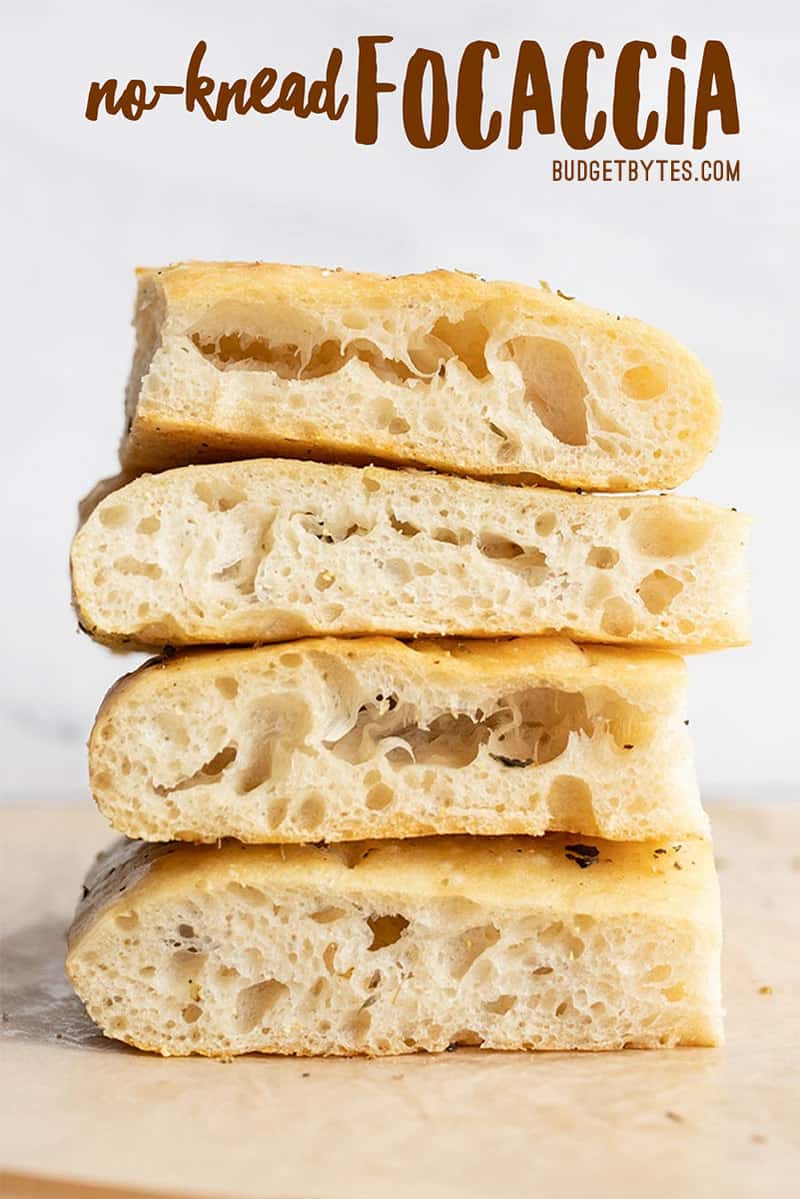
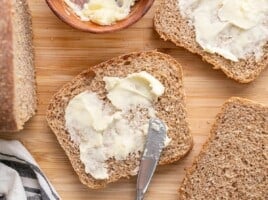
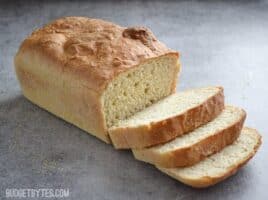
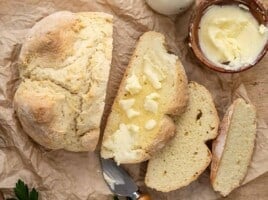
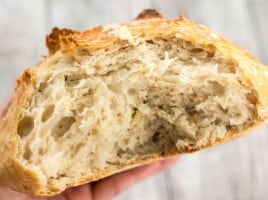
Thank you so much for the wonderful recipe! I’ve never made actual bread before, only cakes like muffins and banana bread, so I was happy to find a quick, easy recipe. I made half a batch and used half whole wheat flour, half pastry flour. After rising, I cut my dough into 6 pieces, each about the size of a standard piece of bread. I experimented with different toppings on each, like rosemary, italian herbs, parmesan cheese, sesame seeds. These baked into the best little sandwich buns ever!!! I can’t wait to make more! Thanks for the awesome recipes and website. :)
I love all your bread recipes, they’re so easy! I was wondering if it makes a difference baking with some whole wheat flour or just using all all-purpose flour?
Oh wow I didn’t know you could create a no-knead focaccia.. so much easier!
Made this tonight – delicious! I went with oregano, basil, rosemary and garlic powder and a 16 hour fermenting time. I think I’ll try a rosemary onion version next. Thanks!
i wonder if i can do ahead and use the dough for pizza crustt loll well guess ill seee><
Hmmm, it’s hard to say but I would try it again with a shorter ferment time. You can go as short as 2 hours for that first “overnight” ferment. I don’t know how long you let it go, but try shortening the first rise/ferment and maybe lengthening the second rise. I hope it works better!
I made this a few weeks ago, and it had a great flavor…but it was super super dense. What did I do? :)
Wow – first bread that I’ve ever made from scratch and now I’m wondering why I haven’t done this before?!?! Sooo easy to make and the result was delicious! I had no corn meal on hand so I substituted semolina and it worked fine. Can’t wait to try some more of your no-knead recipes…
One of the easiest and best breads I have made yet. It’s perfect with a college student’s schedule: make it the night before, next morning put it on the baking sheet, let rise while in class, and then bake before work.
Wonderful recipes!!
This is sitting on my counter for baking tomorrow!! Yummmmmmmmy.
Anon – I’ve left it for about 20 before and it does start to degrade a little… It gets kind of dense. I find it works best between 8 and 16 hours. You can even do as little as 2 but it will just have a lighter flavor.
Am I “allowed” :) to leave the dough longer than 14 hours??? Any idea on what the max time allowed would be???
This is amazing!! My husband, 22 month old daughter and I ate the whole thing with dinner last night. YUM and EASY!
Thanks!
Wow, Beth! I did only let it sit for 12 hours and still AMAZING. We are making a second batch tomorrow. Your blog rocks!
I’m in college and have never baked bread before but it turned out awesome in my little apartment! Definitely will be using this recipe in the future =)